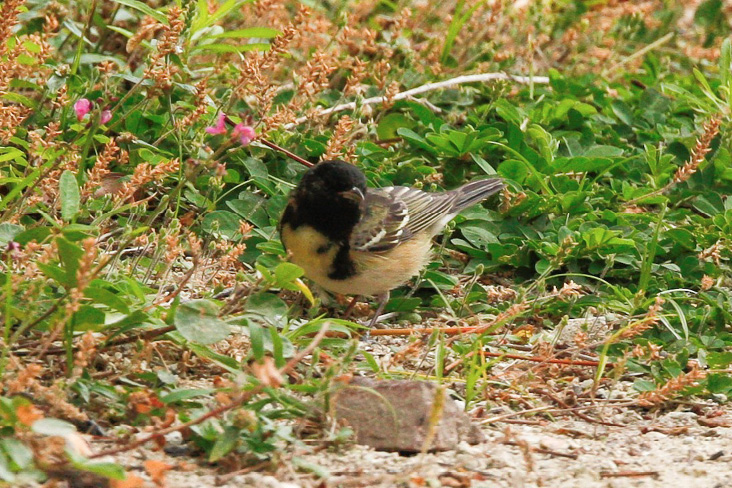Wayne R. Petersen

Carl Goodrich
Here we go again—another anomalous-looking bird! In spite of what some experienced birders may say, precise bird identification, even after lots of practice, is not always straightforward or possible. This issue's mystery photo may be just such a case.
A knee-jerk impression could suggest a Lapland Longspur in breeding plumage, but a look at the nonconical bill and the absence of a broad white stripe bordering the black face and behind the eye can quickly dispel that possibility. Another quick impression might be an aberrant male American Redstart, but how about those neat wing bars and the absence of large orange bases to the tail feathers? Clearly neither of these options is a good fit. So let's concentrate on other features of this curious-appearing species.
This is a case where the color view of the web version of the mystery species may be helpful. In color, in addition to having obvious white wing bars, the bird appears to have a hint of dusky streaking on its back, broad pale edges to the tertials, a distinct wash of yellowish on the mid-breast, a light blush of buff on the sides and flanks, and pinkish-gray legs. This combination of features, along with the obvious black head and throat, hardly matches any North American bird species.
Returning to what you do have to work with, try imagining the bird without any black on its head, throat, or sides of its upper breast. What does the rest of the bird look like? And here I must freely admit that I never saw this bird in life. However, with the black areas obscured I would hazard that the rest of the bird looks suspiciously like a female or autumn-plumaged Bay-breasted Warbler (Setophaga castanea). Additionally, super close scrutiny of the colored photograph suggests that there is a hint of chestnut bordering the left edge of the black on the bird's breast, and possibly also in the vicinity of the bird's right shoulder. The overall small size of the bird compared to the surrounding vegetation, as well as the slimness of its legs and its overall plumpness, further reinforces the impression of a Bay-breasted Warbler. So what's going on with this bird?
The answer to this question is not obvious and may not be accurately determined without more genetic information. Indications are, however, that the mystery species is either a melanistic or schizochroistic Bay-breasted Warbler, where an excess of black pigment (i.e. melanin) has replaced much of what should normally have been chestnut or buff in color. Additionally, the underparts and flanks are also lacking in chestnut but are completely lacking in melanin, too. These features suggest that the complexity of this bird's plumage abnormalities involve more than simply an excess of melanin. This mystery bird is likely exhibiting abnormalities that are beyond resolution from this photograph alone, even though the species involved is almost certainly a Bay-breasted Warbler.
Regardless of its positive identity, this mystery warbler was photographed by Carl Goodrich in the Dry Tortugas off Key West, Florida, in late April 2008.